At this point, we had about 3 miles left to go.

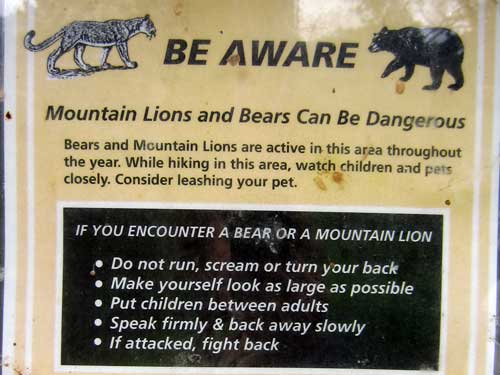
Along with regular trail markers were also the occasional safety signs, reminding us that we were walking through someone else's home.

Boulder offers what is called a "voice and sight control" tag option instead of requiring a leash. Basically it means that your dog must always remain within your line of sight and that it will come instantly when you call, no matter what. While a nice idea, this rule is not enforced and hence highly ineffective. It isn't unusual to see a person yelling helplessly for their dog as it bounds away through a meadow after some hapless bunny, squirrel or deer.... or potentially much worse such as a coyote or a bear. Most often, it is the wild animal that pays the price, not the instigating canine pet.

Yes, he's very cute... but with such freedom must also come serious responsibility.

Some other rules... no fires, no smoking, no camping, no firearms, no glass.... no hang-gliding? Darn! You mean I dragged it all this way for nothing?
As we approached the junction with Bear Canyon, our trail suddenly vanished into a river gully. Fortunately a stable log helped us across. In talking with some other hikers, we learned this had started with the flood but had been growing wider and wider each year.



We all made it across safely.

Following the trail signs

Common or Silvery Lupine is a member of the legume or pea family. The name 'Lupin' comes from the Latin word meaning wolf. It was once believed that these plants ravaged the land, eating all the nutrients out of the soil and making it poor. It is now understood that these plants can make their own nutrients in conjunction with bacteria found in nodules on their roots. Therefore lupines can grow in soils that are too poor for other plants as opposed to causing the soil to be poor.

Another interesting fact about lupines: these white bits will turn red when the flowers have been pollinated. Although bees have a fairly broad color range, they can not see red. Hence they are attracted by the white centers of un-pollinated flowers but will ignore any red-centered ones. Very effecient!

Darcy captures the moment.
At about this point, the clouds had moved in and the air started to cool off. The weather can change very quickly in the mountains.



Starting up our third steep climb that switchbacked up the hill (the red arrow points to a hiker further up the path)


Conifers, such as this Ponderosa Pine, are gymnosperms, meaning their seeds are not enclosed in any type of fruiting body. Gymnosperms have flowers too, but we call them 'cones.' Each tree has both male (smaller, right) and female (larger, left) cones. Unlike with regular flowers, the pollen from male cones isn't carried to female cones by insects but rather by the wind.

Scarlet Gilia or Skyrocket is at first confusing to identify since flower color can range from pure white to flaming red to everything in between. But in the end, they all belong to the same species... and sometimes a single plant is even capable of having several different colors. The color difference is based on what pollinator the plant is trying to attract... hummingbirds with the red, or long-tongued moths with the white.

An expansive view of Boulder far below

Also a lovely view of nearby NCAR (National Center for Atmospheric Research). You can read more about this fascinating place from one of my other reports.

Some impressive trail work

At the top of this giant hillside of rocks sits Wood's Quarry...

By the early 1880's, flagstone (a generic term for sedimentary rock split into layers... in this case, sandstone) began to replace the existing wooden sidewalks in Boulder and Denver. The Woods-Bergheim Quarry (run by Jonas Bergheim and Frank Wood) began operation in the late 1890's to help meet that need. But the trip up and down to the quarry was steep and dangerous. Woods proposed building a tramway, but competition from quarries with easier access eventually caused the quarry to close. The city of Boulder purchased it in 1920 to prevent additional development.

Cactus in the mountains? Prickly Pear is highly adaptable to many conditions, including cold and drought. It also differs from other plants in that it does its photosynthesis at night (instead of during the day) when the air is cooler and less water will evaporate.
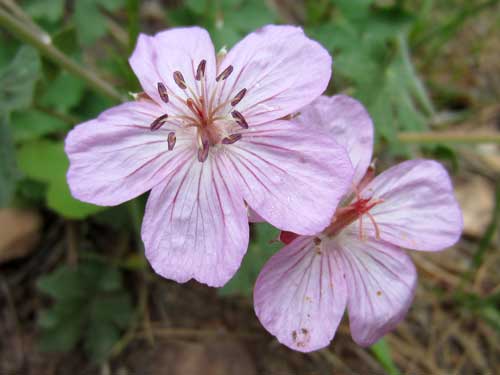
Wild Geranium ranges from white to light pink. 'Geranium' comes from the Greek 'geranos', meaning crane, referring to the long, pointed seed pod that resembles a crane's bill.
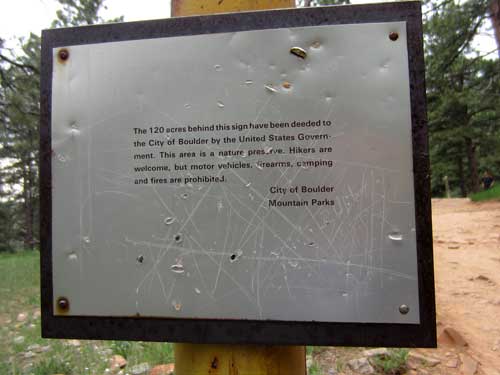
The Boulder parks system began in 1898 when voters approved the purchase of the 75-acre Bachelder Ranch to establish a chautauqua (more details about this at the end of the hike). Today, it encompasses over 45,000 acres and is the largest open space area in the US.

Little is known about the history of Roosa Cabin, which was once part of an old family homestead and actually sits on a small, privately owned parcel of land.

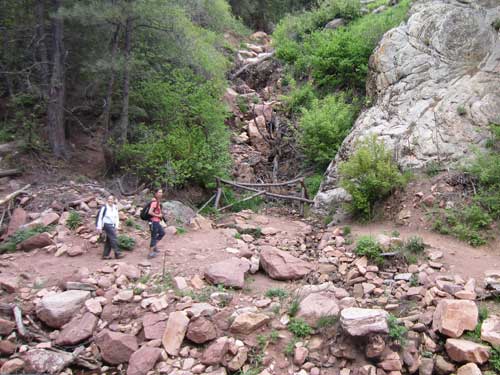
This is another clear example of flood damage. The enormous channel cut into the hillside didn't exist prior to that.


Taking shortcuts, stepping off the trail so you don't get your shoes muddy, wandering over to pick a flower... what harm could one person do? True, perhaps. But it isn't just about one person doing these things. With an annual visitation of 5.3 million people per year (with this core area receiving 1.8 million visits), maintenance is becoming increasingly important to preserve the quality of Boulder's Open Space & Mountain Parks.
Then before we knew it, we found ourselves at the end of the trail! We had made it to Chautauqua!

Distances we covered

The final stretch


Boulder's iconic view of the flatirons. These five imposing slabs of sedimentary stone are estimated to be around 290 million years old. They were lifted and tilted into their present orientation between 35 and 80 million years ago. Originally they were known as the Chautauqua Slabs (circa 1900) and The Crags (circa 1906). The story of the current name is that a pioneer women said they looked like the flat, metal irons used to iron clothes.
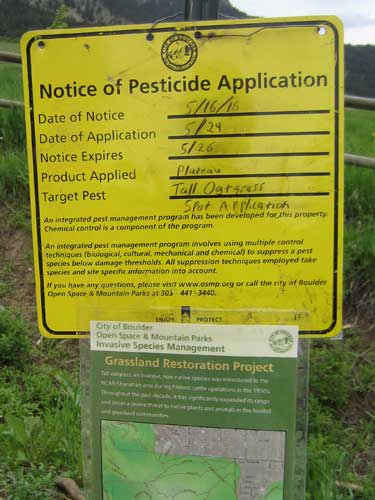
I was a bit shocked to see eco-friendly Boulder resorting to pesticides. Apparently Plateau is a general use pesticide for various invasive grasses. Its active ingredient is Imazapic. According to studies, it at least has a low acute toxicity to mammals, birds, fish and, highly important, to bees. Chronic exposure, however could lead to some muscle deterioration, tissue death and anemia. Because it can be quickly transported to all parts of a plant, it can't be used on food crops. Unfortunately due to its persistence and mobility, Imazapic has a moderate potential for ground water contamination. So, perhaps it isn't as evil and toxic as other pesticides, but I personally was a bit disappointed.

The ranger station...

,,, with its colorful garden of native plants
Chautauqua is an Iroquois word meaning “a bag tied in the middle” or “two moccasins tied together” and describes the shape of Chautauqua Lake, located in southwest New York. This was where the Chautauqua Movement began.
In 1874, John Heyl Vincent and Lewis Miller rented a camp to use as a summer school for Sunday school teachers. Within a few years, it expanded to include adult education of all kinds with a focus on working and middle-class people. Soon concerts and social activities were added. And thus was born the country's first national mass educational and cultural movement. It spread quickly (especially to rural areas where opportunities for secondary education were limited), promoting the ideals of lifelong learning, love of nature (which could uplift both the heart and the mind), and the arts. At the height of the movement, about 1915, some 12,000 communities had hosted a chautauqua.
Until the mid-19th century, vacations were only for the wealthy. Chautauquas provided nearby, affordable getaways. Families and individuals could stay for a day or several weeks, living in cabins or tents; the price was around $5.00 per week with a meal costing some 35 cents.
In the late 1890's, the Texas Board of Regents wanted to establish a summer school for teachers in a cooler climate. The Chautauqua Movement was already quite popular, so the board partnered with them, a railroad company, and a small Colorado town... Boulder. On July 4th, 1898, over 4,000 people gathered for the opening day. The six-week program was claimed to be "the most comprehensive intellectual retreat ever presented west of the Mississippi River.”
The movement had mostly died out by the mid-1930s. There are many possible reasons: cars, radio, movies, the rise in fundamentalism and evangelical Christianity in the 20's, professional and educational opportunities for women, and finally, the Great Depression.
The Colorado Chautauqua is one of only a few remaining chautauquas in the U.S. There are still almost 100 cottages on the premises (although a fair percentage are now privately owned).


A sample day
We celebrated our successful walk with lunch at the Chautauqua Dining Hall. It was built by the city of Boulder (along with the nearby auditorium) for opening day back in 1898.




There were several interesting historic photos on the walls. This one is of the dining hall when folks used to arrive by horse and buggy.


One of the many small cabins visitors could stay in

Note the flatirons in the background

We ate, drank and were merry!

Ned shared with me our adventure in digital form. This makes it look so easy!

After lunch, those of us who had left our cars at the other end of the trail were shuttled back to collect them. Darcy truly did a wonderful job organizing everything!


